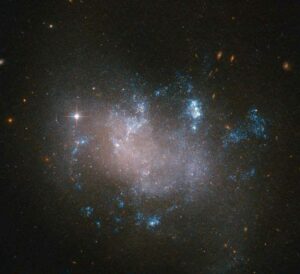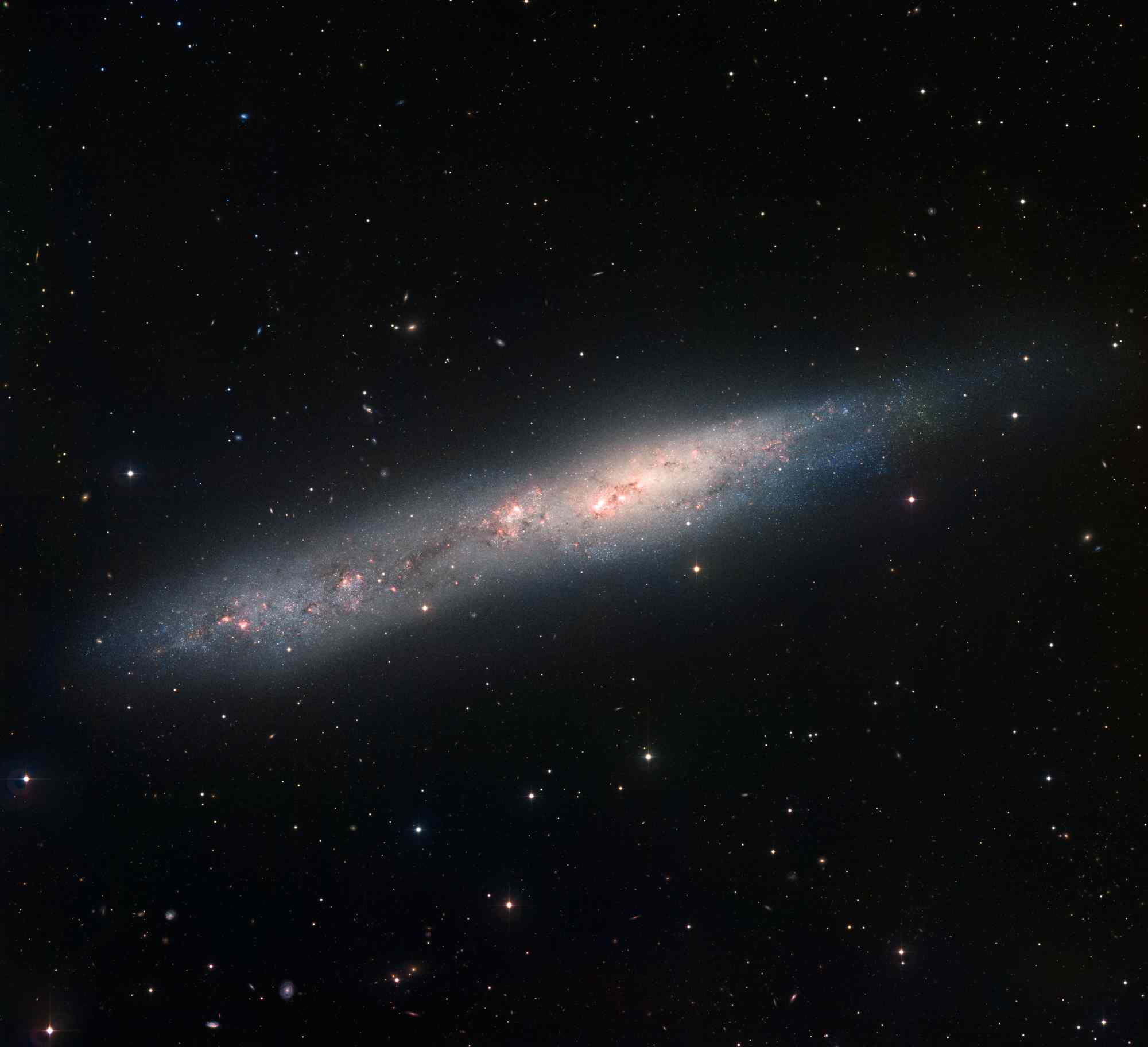*This post may contain affiliate links. This means we may make a commission if you purchase an item using one of our links*
Galaxies are categorized using the Hubble Classification, which includes elliptical and spiral shaped galaxies. Any galaxy that does not fit into either an elliptical or spiral shape is categorized as irregular.
So an irregular galaxy is one that does not have a discernible shape. But there is much more to understanding them than just this.
How Are Irregular Galaxies Formed?
Table of Contents
It is not known for certain how irregular galaxies are formed, but there are some hypotheses with evidence to back them up.
One of these hypotheses states that irregular galaxies might be formed from collisions between other galaxies, creating the unusual shape. Furthermore, these galaxies are considered young, as they are measured to be older than spiral galaxies but younger than elliptical galaxies.
What this means is that irregular galaxies might have initially been separate, distinct spiral galaxies that ended up colliding with one another. Once this happened, the spiral shape was lost and the irregular shape emerged.
It is thought that eventually, as stars are formed (and the materials in these galaxies are therefore used up), these galaxies will become elliptical in shape.
If correct, this would mean that irregular galaxies are the middle stage between spiral and elliptically shaped galaxies.
Do Irregular Galaxies Have A Black Hole?

While it is impossible to refer to every irregular galaxy in our universe with certainty, it is very likely many, if not most, do contain black holes. In fact, three supermassive black holes were discovered by researchers in an irregular galaxy known as NGC 6240!
Scientists generally believe that each galaxy, throughout its lifespan, should create a supermassive black hole. If each galaxy existed on its own, without interaction from anything else in the universe, then perhaps it would be the case that each galaxy could be said to contain a black hole.
However, this is not the case, as we mentioned earlier, the galaxies themselves can even merge!
This means that black holes themselves can merge during galaxy collisions, and while they are likely to remain in the newly formed galaxy, it is not a guarantee that they will.
Overall, this suggests that irregular galaxies have been found to have black holes, and it is reasonable to suspect they can and do have them generally, just like with the other types of galaxies.
What Causes An Irregular Galaxy To Form?
As previously mentioned, it is not fully known how these galaxies form. However, they are believed to be the result of galaxy collisions.
When one galaxy collides with another, they will merge. This merger leads to the loss of the original shapes of each individual galaxy, leaving the unusual, irregular shape.
How Many Irregular Galaxies Are Out There?

Irregular galaxies comprise about a fourth of the total number of galaxies out there, so they are technically in the minority.
In the Hubble Classification system, there are two main types of irregular galaxies: Irr I and Irr II.
Irr I have some semblance of a shape, but not enough to be able to be placed in either the elliptical or spiral categories. Irr II are lacking any semblance of a shape.
It is also important to note there are smaller galaxies called dwarf irregulars as well that comprise the total number.
How Many Stars Does The Average Irregular Galaxy Have?
It is hard to give an average number of stars in irregular galaxies because there is a fair amount of variation amongst them.
For example, some irregular galaxies are noted to be forming stars (thus their totals are increasing), while others do not appear to be forming stars actively. This falls in line with the notion that these are still developing galaxies; they have not reached their end state yet.
Two of the most well-known irregular galaxies are the Large and Small Magellanic Clouds. While the Large Magellanic Cloud is estimated to have about 30 billion stars, the Small Magellanic Cloud is estimated at a vastly smaller 3 billion stars!
This is why it is so difficult to pinpoint an average. After all, the average of 3 and 30 is 16.5, which is not an accurate representation of either of the aforementioned galaxies.
Furthermore, it is acknowledged that irregular galaxies contain both young and old stars, meaning whatever total number of stars currently exists might change with future star formation.
Summary
An irregular galaxy is one that does not neatly fit into the category of spiral or elliptical in shape. They are further broken down by the amount of disorganized they appear to be, with those having some semblance of a shape known as Irr I and those without such semblance called Irr II.
These galaxies are thought to be the result of collisions between galaxies. Their age is between elliptical and spiral galaxies, with them being younger than the elliptical but older than spiral, suggesting they are the middle stage between these two shapes.
In other words, it is possible the original galaxies were spiral shaped that merged, and over time will eventually become an elliptical galaxy.
This suggests that spiral galaxies can collide and merge, with the merger resulting in an irregularly shaped galaxy. They contain materials in abundance, explaining why star formation is common in this type of galaxy.
Additionally, it is likely the black holes that may have been present in the initial galaxies will also merge and remain within the newly formed galaxy. It is not certain this will happen, but does seem like the most likely outcome.
Irregular galaxies comprise only about a quarter of the total number of galaxies, and they vary greatly with regard to number of stars. Consider that the Small Magellanic Cloud has 3 billion stars, while the Large Magellanic Cloud has around 30 billion!
That is quite clearly a massive difference, and speaks not solely to the variation in star numbers themselves but also in size differences between irregular galaxies.
This size difference is also acknowledged by the existence of dwarf irregular galaxies, which are among the smallest.
References
https://astronomy.swin.edu.au/cosmos/i/Irregular+Galaxy
https://astronomy.swin.edu.au/cosmos/H/Hubble+Classification
https://askanearthspacescientist.asu.edu/irregular-galaxies
Three Supermassive Black Holes Discovered at the Core of One Galaxy
https://www.britannica.com/science/galaxy/Irregular-galaxies
https://www.schoolsobservatory.org/learn/astro/gals/class/irregular

